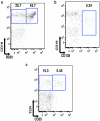Nonredundant roles for B cell-derived IL-10 in immune counter-regulation
- PMID: 19620304
- PMCID: PMC2772089
- DOI: 10.4049/jimmunol.0900185
Nonredundant roles for B cell-derived IL-10 in immune counter-regulation
Abstract
IL-10 plays a central role in restraining the vigor of inflammatory responses, but the critical cellular sources of this counter-regulatory cytokine remain speculative in many disease models. Using a novel IL-10 transcriptional reporter mouse, we found an unexpected predominance of B cells (including plasma cells) among IL-10-expressing cells in peripheral lymphoid tissues at baseline and during diverse models of in vivo immunological challenge. Use of a novel B cell-specific IL-10 knockout mouse revealed that B cell-derived IL-10 nonredundantly decreases virus-specific CD8(+) T cell responses and plasma cell expansion during murine cytomegalovirus infection and modestly restrains immune activation after challenge with foreign Abs to IgD. In contrast, no role for B cell-derived IL-10 was evident during endotoxemia; however, although B cells dominated lymphoid tissue IL-10 production in this model, myeloid cells were dominant in blood and liver. These data suggest that B cells are an underappreciated source of counter-regulatory IL-10 production in lymphoid tissues, provide a clear rationale for testing the biological role of B cell-derived IL-10 in infectious and inflammatory disease, and underscore the utility of cell type-specific knockouts for mechanistic limning of immune counter-regulation.
Figures








Similar articles
-
Regulatory B cell (B10 Cell) expansion during Listeria infection governs innate and cellular immune responses in mice.J Immunol. 2013 Feb 1;190(3):1158-68. doi: 10.4049/jimmunol.1201427. Epub 2012 Dec 28. J Immunol. 2013. PMID: 23275601 Free PMC article.
-
IL-10 restricts memory T cell inflation during cytomegalovirus infection.J Immunol. 2010 Sep 15;185(6):3583-92. doi: 10.4049/jimmunol.1001535. Epub 2010 Aug 16. J Immunol. 2010. PMID: 20713884 Free PMC article.
-
Four distinct patterns of memory CD8 T cell responses to chronic murine cytomegalovirus infection.J Immunol. 2006 Jul 1;177(1):450-8. doi: 10.4049/jimmunol.177.1.450. J Immunol. 2006. PMID: 16785542
-
Regulatory CD8+ T cells associated with erosion of immune surveillance in persistent virus infection suppress in vitro and have a reversible proliferative defect.J Immunol. 2013 Jul 1;191(1):312-22. doi: 10.4049/jimmunol.1201773. Epub 2013 Jun 3. J Immunol. 2013. PMID: 23733872 Free PMC article.
-
IL-10-producing regulatory B cells in the pathogenesis of chronic hepatitis B virus infection.J Immunol. 2012 Oct 15;189(8):3925-35. doi: 10.4049/jimmunol.1103139. Epub 2012 Sep 12. J Immunol. 2012. PMID: 22972930 Free PMC article.
Cited by
-
Regulatory CD8(+)CD122 (+) T-cells predominate in CNS after treatment of experimental stroke in male mice with IL-10-secreting B-cells.Metab Brain Dis. 2015 Aug;30(4):911-924. doi: 10.1007/s11011-014-9639-8. Epub 2014 Dec 25. Metab Brain Dis. 2015. PMID: 25537181 Free PMC article.
-
Wogonin Suppresses IL-10 Production in B Cells via STAT3 and ERK Signaling Pathway.J Immunol Res. 2020 Jun 1;2020:3032425. doi: 10.1155/2020/3032425. eCollection 2020. J Immunol Res. 2020. PMID: 32566686 Free PMC article.
-
Cellular Sources and Neuroprotective Roles of Interleukin-10 in the Facial Motor Nucleus after Axotomy.Cells. 2022 Oct 9;11(19):3167. doi: 10.3390/cells11193167. Cells. 2022. PMID: 36231129 Free PMC article.
-
Regulatory B cell (B10 Cell) expansion during Listeria infection governs innate and cellular immune responses in mice.J Immunol. 2013 Feb 1;190(3):1158-68. doi: 10.4049/jimmunol.1201427. Epub 2012 Dec 28. J Immunol. 2013. PMID: 23275601 Free PMC article.
-
Type I IFN signaling facilitates the development of IL-10-producing effector CD8+ T cells during murine influenza virus infection.Eur J Immunol. 2016 Dec;46(12):2778-2788. doi: 10.1002/eji.201646548. Epub 2016 Nov 9. Eur J Immunol. 2016. PMID: 27701741 Free PMC article.
References
-
- Moore KW, de Waal Malefyt R, Coffman RL, O’Garra A. Interleukin-10 and the interleukin-10 receptor. Ann. Rev. Immunol. 2001;19:683–765. - PubMed
-
- Couper KN, Blount DG, Riley EM. IL-10: the master regulator of immunity to infection. J. Immunol. 2008;180:5771–5777. - PubMed
-
- Jankovic D, Trinchieri G. IL-10 or not IL-10: that is the question. Nature Immunol. 2007;8:1281–1283. - PubMed
-
- Gazzinelli RT, Wysocka M, Hieny S, Scharton-Kersten T, Cheever A, Kuhn R, Muller W, Trinchieri G, Sher A. In the absence of endogenous IL-10, mice acutely infected with Toxoplasma gondii succumb to a lethal immune response dependent on CD4+ T cells and accompanied by overproduction of IL-12, IFN-gamma and TNF-alpha. J. Immunol. 1996;157:798–805. - PubMed
Publication types
MeSH terms
Substances
Grants and funding
LinkOut - more resources
Full Text Sources
Other Literature Sources
Molecular Biology Databases
Research Materials

